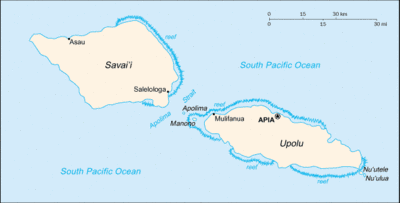Welcome to the Virtual Education Wiki ~ Open Education Wiki
Samoa: Difference between revisions
Jump to navigation
Jump to search

m (→References) |
(→Samoa in a nutshell: added narrative) |
||
| Line 4: | Line 4: | ||
== Samoa in a nutshell == | == Samoa in a nutshell == | ||
''Samoa'', officially the '''Independent State of Samoa''' (formerly known as '''Western Samoa''' and '''German Samoa'''), is a country governing the western part of the Samoan Islands in the South Pacific Ocean. The entire island group, inclusive of American Samoa, was called Navigators Islands by European explorers before the 20th century because of the Samoans' seafaring skills. | |||
Samoa became independent from [[New Zealand]] in 1962. | |||
The two main islands of Samoa are Upolu and Savai'i (one of the biggest islands in Polynesia). | |||
The population of Samoa is 179,000. | |||
The capital (and largest city) is Apia, situated on the island of Upolu. | |||
Samoa was admitted to the United Nations on 15 December 1976. | |||
[[Image:samoa.gif|center|thumb|400px|Source : http://www.cia.gov]] | [[Image:samoa.gif|center|thumb|400px|Source : http://www.cia.gov]] | ||
Revision as of 21:29, 4 January 2010
Partners situated in Samoa
Samoa in a nutshell
Samoa, officially the Independent State of Samoa (formerly known as Western Samoa and German Samoa), is a country governing the western part of the Samoan Islands in the South Pacific Ocean. The entire island group, inclusive of American Samoa, was called Navigators Islands by European explorers before the 20th century because of the Samoans' seafaring skills.
Samoa became independent from New Zealand in 1962.
The two main islands of Samoa are Upolu and Savai'i (one of the biggest islands in Polynesia).
The population of Samoa is 179,000.
The capital (and largest city) is Apia, situated on the island of Upolu.
Samoa was admitted to the United Nations on 15 December 1976.

Source : http://www.cia.gov